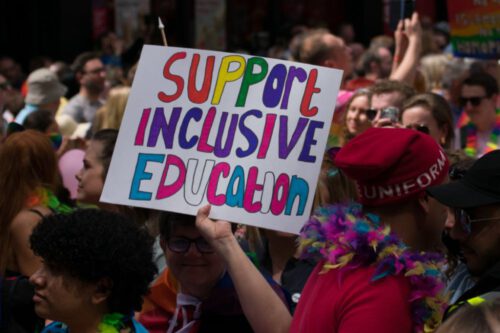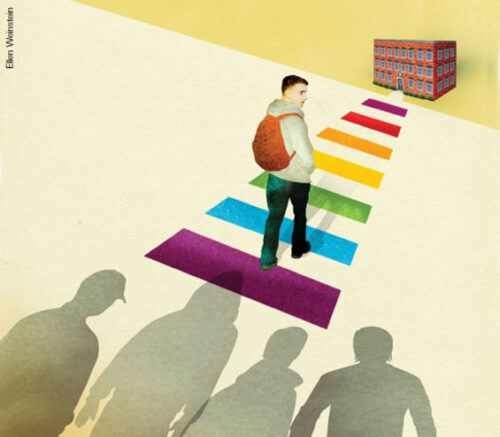In the course Traineeship I- Skills and Knowledge, students research on a topic of their interest and gain knowledge about the topic. Lotte van Aperen shared her research with us on gender sexuality alliance. Enjoy the read!
Abstract
Gender Sexuality Alliances (GSA’s) are student led initiatives in middle- and high-schools
aimed at improving the social situation for sexuality and gender diverse (SGD) individuals, as
they are often faced with mental health risks due to victimization. GSA’s could reduce this
victimization or mitigate its effects by providing support through different strategies, three of
which are discussed in this review: Anti-bullying programs, sex-education programs and
intergroup contact programs. For each of these strategies effectivity is discussed in terms of
reduction of victimization and provision of support. Recommendations for research and
practice are provided.
How Gender Sexuality Alliances Could Make a Difference: Bullying, Sex-Education and Intergroup Contact

Gender Sexuality Alliances (GSA’s), formerly known as Gay-Straight Alliance, are
student led initiatives in middle- or high schools, aimed at improving the social situation for
sexuality and gender diverse (SGD) individuals (Mission, Vision, & History, GSA Network,
2025; Kaufman et al., 2024), as these individuals are at a disproportionate risk to develop
various (mental) health issues, including depression, substance abuse and suicide (Klinger et
al., 2024; Moagi et al. 2021; Dürrbaum & Sattler, 2020). In the scientific literature,
explanations for these negative outcomes for SGD people are not provided by their sexual
orientation or gender identity directly, but through e.g. discrimination and victimization
(Moagi et al., 2021; Goldbach et al., 2013; Marraccini et al., 2021). Decreasing this
victimization could therefore be a goal of GSA’s as it likely decreases the risk of mental
health issues in SGD individuals. Another goal could be providing support to those who are
victimized as it could mitigate the effects of this victimization on mental health (Fredriksen-
Goldsen et al., 2014). This effect has been found for example regarding substance abuse
(Watson et al., 2020) and suicidality and depression (Rivas-Koehl et al., 2021). What is not
exactly clear however, is whether and how GSA’s might be effective in obtaining these goals.
Apart from the common goal of improving the social situation for SGD individuals, no
set definition exists for what activities a GSA employs (Nederlands Jeugdinstituut, 2020).
This makes it somewhat difficult to conduct research on their effects, since GSA’s might vary
in terms of activity, focus and strategies, which might yield varying results. The effectivity of
a GSA could be due to its mere existence or by specific programs, which might be
differentially effective in either decreasing the victimization experienced by SGD youth, or in
providing SGD youth with the support that could mitigate the effects of victimization.
For this reason, this review investigates whether and how GSA’s might be effective in
reducing mental health issues for SGD youth, by specifically assessing the effectivity of
different strategies and programs, which might typically be conducted or promoted by a GSA.
First, the effect of the mere existence of a GSA within a school on reducing victimization and
providing support is assessed, regardless of what strategies are implemented. Next anti-
bullying programs and contact programs are assessed which are aimed at reducing
victimization. Although not primarily aimed at reducing victimization or providing support
sex-education will also be discussed, as it might be effective in either by addressing LGBTQ
issues. Due to scarcity of research, most of the studies included have not investigated these
programs as they were implemented by a GSA, but specific effects on SGD youth have been
investigated. To conclude recommendations for research and practice will be provided.

GSA’s
According to most studies, GSA’s are beneficial for the mental health of SGD youth,
but the mechanisms involved, reduction of victimization or provision of support, are
somewhat inconsistent. A meta-analysis by Marx and Kettrey (2016) found that SGD youth
are less likely to experience homophobic victimization and fear for safety in schools with a
GSA compared to schools without a GSA. Moreover, a review by Marraccini et al. (2022)
found that in some studies the effect of having a GSA on suicide related thoughts and
behaviors among SGD youth disappears after controlling for victimization, suggesting that in
these studies reducing victimization was the sole mechanism through which the effect of
GSA’s on suicide related thoughts and behaviors operated. These findings support the
effectivity of GSA’s through the reduction of victimization.
In contrast, Kaufman et al. (2024) found that, although SGD students do perceive
more inclusive climates and more safety to disclose one’s sexual orientation in schools that
have a GSA, this was not related to reduced bullying victimization of SGD youth students.
Similarly Walls et al. (2009) found that students might feel safer in a school with a GSA, but
are not less likely to be harassed. These findings might indicate that these GSA’s were more
successful in mitigating the adverse effects of victimization rather than reducing
victimization. Taken together, the exact mechanisms through which GSA’s might have
beneficial effects on SGD individuals’ mental health are unclear.
This ambiguity might be explained by the ambiguity in the definition of a GSA. Apart
from their mere existence having an effect, GSA’s might be specifically effective in either
decreasing the amount of victimization or protecting against it through the employment of
different activities. Some activities might primarily be effective in mitigating the effects of
victimization, others might effectively decrease victimization and again others might do both.
Therefore the following sections aim to dive into specific programs to directly assess their
effectivity in decreasing and/or providing support that might protect against this victimization.
It should be noted that the possibility exists that having a GSA in a school is a
consequence of a more inclusive climate rather than the cause given the limitation of most
previous research that it is correlational and cross-sectional. However, controlling for the state
in which the school was located, Proulx et al. (2019) still found a positive effect of GSA’s on
mental health for SGD individuals, indicating that this effect might not merely be a reflection
of a more inclusive political climate.
Anti-Bullying Programs

Homophobic and transphobic bullying, a specific kind of victimization, are under-
addressed (Minton, 2014), suggesting that strides can be made in this regard by GSA’s, either
by hosting anti-bullying interventions themselves of advocating for implementation by the
school. According to meta-analyses, anti-bullying programs are effective in reducing
incidence of bullying, although there was also significant heterogeneity and effect sizes were
modest (Hensums et al., 2022; Lee et al., 2013; Jiménez-Barbero et al., 2015). Therefore we
must carefully determine what specific anti-bullying programs might be helpful in reducing
homophobic and transphobic bullying.
Programs that address bullying in general but not homophobic or transphobic bullying
specifically are not effective in reducing this type of bullying (Hall, 2017). Similarly, neither
the mere presence of a GSA, nor the mere presence of anti-bullying programs are sufficient to
reduce the amount of victimization of SGD individuals, whereas the combination is effective
(Kaufman et al., 2024). In order to reduce the amount of bullying with a sexual orientation or
gender identity basis, it is therefore necessary to bring attention to both the bullying behavior
through the programs, and the fact that bullying can be specifically homophobic or
transphobic.
When considering the effect of the bullying on mental health rather than the incidence
of bullying, the picture becomes slightly more complex due to the “healthy context paradox”
(Lucas-Molina et al., 2022) meaning that the adverse effects of bullying could be worsened
when the incidence of bullying is lower. A longitudinal and experimental study showed higher
depressive symptoms and lower self-esteem in those that were still bullied after the
implementation of an anti-bullying program (Huitsing et al., 2018). Although little is known
about the exact mechanisms behind this paradox, it is hypothesized that these individuals have
more difficulty finding social support as they feel more alone and causal explanations of the
victimization are sought internally rather than externally (Lucas-Molina et al., 2022).
Although this paradox has been found in general populations (Huang et al., 2023; Laninga-
Wijnen et al., 2023; Odigie et al., 2024) research has not yet focused on this effect in an SGD
sample.
It is important to consider how this healthy context paradox might affect SGD
individuals in general, but also differentially comparing the subgroups within an SGD group.
As general anti-bullying programs might fail to specifically reduce homophobic and
transphobic bullying, those who are targeted by this type of bullying might suffer from the
healthy context paradox. Moreover, this paradox potentially also occurs within a GSA or SGD
subgroup when success is booked in reducing homophobic bullying, but not in transphobic or
intersectional bullying (Kaufman et al., 2023). Gender diverse individuals tend to have worse
mental health than in sexually diverse individuals and most GSA’s and other interventions
have bigger effects for sexually diverse than for gender diverse youth (Ioverno & Russel,
2020). GSA’s might therefore unintentionally amplify the mental health issues of gender
diverse individuals, should they not be equally sensitive to the needs of all SGD students.
These findings indicate the necessity for GSA’s and anti-bullying interventions to strive to be
as all-encompassing in representation as possible.
Sex-Education Programs

Sex-education aims to equip young people with the necessary knowledge to develop a
healthy sexuality. Whether and how sexual and gender identities are addressed in sex-
education programs offered by schools varies immensely. In the USA, for example, most
states do not require the inclusion LGBTQ issues. Only seven states require an LGBTQ-
inclusive sex-education program, whereas eight actually require sexual and gender diverse
identities to be framed negatively (Tran et al., 2023). The way sexual and gender identities are
discussed in schools could have profound implications for how SGD youth experience their
identity and how they are regarded by the general public. Therefore, sex-education could be of
interest to GSA’s. The following sections will investigate how inclusive sex-education affects
SGD mental health through both paths described earlier: on the one hand through direct
empowerment of SGD individuals by providing information specific to their situation, and on
the other hand through reduction of victimization by promoting understanding in the general
population.
Reviews have found an abundance of evidence that LGBTQ-inclusive sex education is
beneficial for an overall safer school climate, reduced bullying, and better mental health in
SGD individuals (Goldfarb & Lieberman, 2020; Eleuteri et al., 2024). Research has not yet
focused on the possible direct positive effects of inclusive sex-education on SGD youth, in
how they might feel acknowledged by recognizing their identity in education materials for
example. There is however evidence for the inverse effect that SGD youth perceive programs
that exclude LGBTQ issues to deny the existence of their identities (Naser et al., 2020). To
promote inclusion of SGD individuals, inclusive sex-education could therefore be an
appropriate first step.
Inclusive sex-education might on the other hand also be effective by indirectly
addressing LGBTQ issues to all students, who then might become less likely to victimize
SGD individuals. Kesler et al. (2023) found that LGBTQ inclusive sex-education can be
effective in reducing homophobia and transphobia in cisgender heterosexual youth, thereby
creating a safer climate in school. Similarly, a review by Goldfarb and Lieberman (2020)
found that numerous studies find LGBTQ inclusive curricula to increase the understanding of
SGD issues, by dispelling myths about homosexuality and transgender identity for example.
Inclusive sex-education could therefore be effective by decreasing victimization by the
general public.
The findings discussed above suggest that sex-education could be effective via both
paths: directly by providing SGD individuals with accurate information applicable to them
and not denying their identity and indirectly by reducing the amount of victimization through
an improved understanding of SGD issues by the general public. This information could be
especially valuable to GSA’s should the standard sexual health curriculum not be inclusive.
GSA’s could provide not only SGD individuals, but all students with information about
sexuality and gender identity, or by advocating for the school to implement it in their standard
curriculum.
Contact-Based Interventions

One final strategy that this review evaluates is the promotion of intergroup contact
between the dominant group (cisgender heterosexual individuals) and minoritized group
(SGD individuals). Individuals from a dominant group hold more positive attitudes regarding
a minoritized group as they have more contact with them (Van Assche et al., 2023). Moreover,
interventions based on intergroup contact are effective in reducing prejudice regarding
minoritized groups (Lemmer & Wagner, 2015), making these promising for GSA’s.
In the initial intergroup contact hypothesis by Allport (1954) intergroup contact is
described as most effective when characterized by four conditions: Firstly, individuals from
the different groups should have equal status (e.g. students). They also need to have common
goals (e.g. winning a game) and collaborate to achieve those goals. Lastly, there needs to be
support from authorities, law or custom (e.g. supervision by teachers who support
collaboration between cisgender heterosexual and SGD students). Pettigrew and Tropp (2006)
found that effect sizes were significantly larger for studies in which the conditions theorized
by Allport were met compared to studies where they were not, although the effect was still
significant in designs that did not meet these conditions. They are therefore beneficial to
maximize effect, but not necessary. Effect sizes were also slightly larger in studies where
heterosexual and homosexual groups were investigated compared to racial group and in
adolescent and young adult samples compared to middle-aged samples. These findings
indicate that contact-based interventions might be an especially helpful tool for GSA’s in a
school setting.
Another form of contact is parasocial contact, or contact through mass-media
(Schiappa et al., 2005). This way of promoting contact could be of interest for GSA’s by
promoting movies, series or books that contain SGD characters for example. Exposure to
SGD characters in movies and tv-shows can decrease prejudice via personality and attitudinal
recognizability (Zerebecki et al., 2024), meaning that as individuals from the dominant group
recognized shared personality traits and attitudes, their prejudice was more likely to decrease.
However SGD individuals often perceive media representation of their identity as limiting
and one-dimensional (McInroy & Craig, 2016). SGD characters are often exclusively focused
on that particular aspect of their identity, which also negates the ideas of personality and
attitudinal recognizability. These arguments advocate for the representation of
multidimensional SGD characters. GSA’s might therefore prefer to promote media in which
SGD characters consist of more than only their sexual orientation or gender identity.
For GSA’s the promotion of contact could be of interest. In terms of direct intergroup
contact events could be hosted where students work together with SGD students in teams (e.g.
in a game-night or sports events), although selection effects likely remain a restriction in these
settings. Countering these effects would likely require intervention on a teacher or school
level (e.g. random allocation to groups for projects). In terms of parasocial contact GSA’s
could search for and promote accurate and multidimensional representations of SGD
individuals in the media, which is both relevant for the perception of accurate representation
by SGD individuals, but also the ability to relate to these characters for cisgender,
heterosexual individuals, and in turn, the effectivity of diminishing prejudice.
Conclusion
Taken together, GSA’s aim to improve the social situation for SGD individuals in
middle- and high schools. This could be achieved by directly providing SGD students with
support to mitigate the adverse effects of victimization, or indirectly by reducing victimization
in the general population. The literature generally supports GSA’s effectivity towards these
goals (Marx & Kettrey, 2016; Marraccini et al., 2022; Kaufman et al., 2024; Walls et al.,
2009; Proulx et al., 2019), although through which mechanisms is unclear, partly because
GSA’s are not well defined and exact activities that are employed vary from GSA to GSA.
Three specific types of programs are discussed that could be of interest for GSA’s
Firstly, anti-bullying programs seem moderately effective in reducing incidence of
bullying in general (Hensums et al., 2022; Lee et al., 2013; Jiménez-Barbero et al., 2015;
Minton, 2014). Unfortunately specifically homophobic and transphobic bullying are not
targeted well by general programs (Hall, 2017; Kaufman et al., 2024). Only when there is
attention for the bullying behavior as well as this specific basis for bullying are the
interventions effective, and even then caution is warranted due to the healthy context paradox
(Lucas-Molina et al., 2022; Huitsing et al., 2018).
Secondly inclusive sex-education can be a valuable tool for GSA’s. The effect of
inclusive sex-education on SGD youth has not been thoroughly investigated yet. However,
there is literature that describes non-inclusive sex-education to be perceived by SGD youth as
denying of their identities (Naser et al., 2022). The evidence that inclusive sex-education is
beneficial for the understanding of sexual orientations and gender identities by the general
population on the other hand is abundant (Goldfarb & Lieberman, 2020; Eleuteri et al., 2024;
Kesler et al., 2023).
Lastly, direct contact as described by Allport has been repeatedly shown to be effective
in reducing prejudice towards minoritized groups including SGD groups (Van Assche et al.,
2023; Lemmer & Wagner, 2015; Pettigrew & Tropp, 2006). The evidence for parasocial
contact is much scarcer but nevertheless provides an interesting consideration for the
promotion of multidimensional SGD characters in mass media, which might both let SGD
individuals feel more accurately represented and make the characters more relatable for a
cisgender heterosexual audience (Zerebecki et al., 2024; McInroy & Craig, 2016).
Recommendations for Research
The different fields of research that have been discussed in this review tend to have
different focuses. There is either a focus on SGD individuals’ mental health risk due to
victimization and reducing this through support, or there is a focus on reducing the mental
health risks by reducing the victimization. The implications for this distinction will be
discussed per program in the following sections.
Research on GSA’s tends to focus on the effects of GSA’s on the mental health of SGD
youth. This does not allow us to draw conclusions on the effect of a GSA on cisgender
heterosexual students, and the likelihood they would victimize SGD individuals. The
conclusions of the studies that have included victimization vary. Future research should
therefore investigate how GSA’s might address homophobia and transphobia in all students
and possibly teachers. Furthermore, future research should compare the effectivity of GSA’s
that do and do not use particular strategies, in order to disentangle due to which strategies,
which goals can be obtained. Causal inferences are difficult since evidence in this research
area is still largely based on cross-sectional, correlational studies. A true experiment with
random conditions to either implement a GSA or not is unrealistic. However, collecting
longitudinal data and comparing changes in schools in which the implementation of a GSA
occurs naturally could already provide some valuable insights. This would allow us to assess
the precedence of either the implementation of a GSA or the improved school climate.
Furthermore interventions on a smaller scale that aim to approximate the implementation of a
GSA could provide valuable insights.
Research on anti-bullying interventions has logically focused on victimization. A
pitfall in anti-bullying research has been to only focus on incidence rather than effect of
victimization, which has left many studies in the dark about the full effect of an intervention
due to the healthy context paradox. Before any anti-bullying program is promoted for
widespread implementation, it should therefore be examined whether it achieves the intended
goal on multiple indices including but not limited to: incidence of bullying, effect on the
mental health of victims for which the intervention was not effective, and possible differential
effectivity for different subgroups, including but not limited to: sexual orientation, gender
identity, ethnic background and intersectionality.
Research on sex-education shows that inclusive sex-education can reduce homophobia
and transphobia in the general body of students, can reduce victimization, and is associated
with improved mental health. What this line of research does not tend to focus on however, is
the support it might provide for SGD individuals. Although it has been shown that inclusive
sex-education could beneficially affect SGD youth because of the provision of sexual health
information specific to their identity, future research could investigate whether SGD
individuals might also feel supported by receiving the message that their identity is real and
justified.
Contrary to research on GSA’s, research on direct intergroup contact-based
interventions focuses on the effect of these interventions on the attitudes and prejudice of the
dominant group. It should be investigated whether this diminished prejudice translates to
more inclusive behavior and improved mental health for the group that was previously
prejudiced against. Regarding parasocial contact, future research should aim to disentangle
which kinds of portrayals are beneficial and how these effects differ over various identities, as
most have only investigated homosexual men.
A last general point is that often a cisgender, heterosexual group is compared to a non-
cisgender and/or non-heterosexual group, as if they would have the same experiences. There
is an increasing awareness for the variation within a SGD group, but there is still no clear
picture on how these constructs differ between SGD groups. Future research should focus
more on this variation by specifically sampling among a non-cisgender and non-heterosexual
population and compare subgroups, as not all orientations and identities might face the same
kinds and levels of victimization, or react to it in the same way.
Recommendations for Practice

Schools that do not have a GSA in place would likely benefit from implementing one.
Guidance is provided by the overarching GSA initiative https://gsanetwork.org/. For GSA’s
that are already implemented, this review could provide recommendations regarding the
effectivity of various programs.
General anti-bullying programs might leave an SGD group vulnerable to the healthy
context paradox. Programs that want to target homophobic and transphobic bullying as well
should therefore pay specific attention to these kinds of bullying. This however only negates a
possible systematic basis for the healthy context paradox, but not the healthy context paradox
overall. It might therefore be wise to check in on the mental health of victims of bullying in
schools that have an anti-bullying program in place.
Sex-education programs can counteract homophobic and transphobic myths creating a
greater understanding for SGD individuals among all students. Ideally this is already
incorporated in the school-based sex-education program. Should it not be, GSA’s might
provide students with gender-identity and sexuality specific sexual health information, or
address this issue to the school to have SGD information and representation included in the
standard curriculum. GSA network provides peer education materials (GSA Network, 2025).
Direct intergroup contact programs which adhere to the four criteria formulated by
Allport are promising for the reduction of prejudice against SGD individuals. Although
selection effects might play a role which creates difficulty in targeting the individuals with the
most negative perceptions of SGD individuals, prejudice could still be reduced through those
with moderate perceptions of SGD individuals. Parasocial contact could be more beneficial
for targeting larger masses simultaneously, for example by promoting movies and tv-shows
that have multidimensional SGD characters.
In conclusion there are various strategies which have promising potential of reducing
mental health risk in SGD individuals, either through reduction in victimization, or provision
of support. More strategies exist which have not been discussed in this review. The
evaluations of the programs that were included, might however be a helpful starting point for
GSA’s that want to look into how to be as effective as possible.
Author: Lotte van Aperen
References
Allport, G. W. (1954). The nature of prejudice. Addison-Wesley
Dürrbaum, T., & Sattler, F. A. (2019). Minority stress and mental health in lesbian, gay
male, and bisexual youths: A meta-analysis. Journal Of LGBT Youth, 17(3), 298–314.
https://doi.org/10.1080/19361653.2019.1586615
Eleuteri, S., Girardi, M., Spadola, R., & Todaro, E. (2024). Inclusion Goals: What Sex
Education for LGBTQIA+ Adolescents? Children, 11(8), 966.
https://doi.org/10.3390/children11080966
Goldbach, J. T., Tanner-Smith, E. E., Bagwell, M., & Dunlap, S. (2013). Minority
Stress and Substance Use in Sexual Minority Adolescents: A Meta-analysis. Prevention
Science, 15(3), 350–363. https://doi.org/10.1007/s11121-013-0393-7
Goldfarb, E. S., & Lieberman, L. D. (2020). Three Decades of Research: The Case for
Comprehensive Sex Education. Journal Of Adolescent Health, 68(1), 13–27.
https://doi.org/10.1016/j.jadohealth.2020.07.036
GSA Network. (z.d.). GSA Network. https://gsanetwork.org/resources/
Hall, W. (2017). The Effectiveness of Policy Interventions for School Bullying: A
Systematic Review. Journal Of The Society For Social Work And Research, 8(1), 45–69.
https://doi.org/10.1086/690565
Hensums, M., De Mooij, B., Kuijper, S. C., Cross, D., DeSmet, A., Garandeau, C. F.,
Joronen, K., Leadbeater, B., Menesini, E., Palladino, B. E., Salmivalli, C., Solomontos-
Kountouri, O., Veenstra, R., Fekkes, M., & Overbeek, G. (2022). What Works for Whom in
School-Based Anti-bullying Interventions? An Individual Participant Data Meta-analysis.
Prevention Science, 24(8), 1435–1446. https://doi.org/10.1007/s11121-022-01387-z
Huang, Y., Gan, X., Jin, X., Wei, Z., Cao, Y., & Ke, H. (2023). The healthy context
paradox of bullying victimization and academic adjustment among Chinese adolescents: A
moderated mediation model. PLoS ONE, 18(8), e0290452.
https://doi.org/10.1371/journal.pone.0290452
Huitsing, G., Lodder, G. M. A., Oldenburg, B., Schacter, H. L., Salmivalli, C.,
Juvonen, J., & Veenstra, R. (2018). The Healthy Context Paradox: Victims’ Adjustment
During an Anti-Bullying Intervention. Journal Of Child And Family Studies, 28(9), 2499–
2509. https://doi.org/10.1007/s10826-018-1194-1
Ioverno, S., & Russell, S. T. (2020). Homophobic Bullying in Positive and Negative
School Climates: The Moderating Role of Gender Sexuality Alliances. Journal Of Youth And
Adolescence, 50(2), 353–366. https://doi.org/10.1007/s10964-020-01297-9
Jeynes, W. H. (2019). A Meta-Analysis on the Relationship Between Student
Abstinence-Only Programs and Sexual Behavior and Attitudes. Education And Urban Society,
52(1), 3–20. https://doi.org/10.1177/0013124519848045
Jiménez-Barbero, J. A., Ruiz-Hernández, J. A., Llor-Zaragoza, L., Pérez-García, M., &
Llor-Esteban, B. (2015). Effectiveness of anti-bullying school programs: A meta-analysis.
Children And Youth Services Review, 61, 165–175.
https://doi.org/10.1016/j.childyouth.2015.12.015
Kaufman, T. M. L., Kiekens, W. J., Baams, L., Bos, H. M. W., & De Looze, M. E.
(2024). Gender Sexuality Alliances and School Safety: Who Benefits Most, and Do Additive
School-Led Practices Strengthen the Link? Journal Of Youth And Adolescence, 53(7), 1499–
1512. https://doi.org/10.1007/s10964-024-01957-0
Kaufman, T. M. L., Lessard, L. M., & Watson, R. J. (2023). Heterogenous associations
between Gender‐Sexuality Alliances and LGBTQ adolescents’ maladjustment across
individual victimization level. Journal Of Research On Adolescence, 33(3), 890–898.
https://doi.org/10.1111/jora.12844
Kesler, K., Gerber, A., Laris, B., Anderson, P., Baumler, E., & Coyle, K. (2023). High
School FLASH Sexual Health Education Curriculum: LGBTQ Inclusivity Strategies Reduce
Homophobia and Transphobia. Prevention Science, 24(S2), 272–282.
https://doi.org/10.1007/s11121-023-01517-1
Klinger, D., Oehlke, S., Riedl, S., Eschbaum, K., Zesch, H. E., Karwautz, A., Plener, P.
L., & Kothgassner, O. D. (2024). Mental health of non-binary youth: a systematic review and
meta-analysis. Child And Adolescent Psychiatry And Mental Health, 18(1).
https://doi.org/10.1186/s13034-024-00822-z
Laninga-Wijnen, L., Yanagida, T., Garandeau, C. F., Malamut, S. T., Veenstra, R., &
Salmivalli, C. (2023). Is there really a healthy context paradox for victims of bullying? A
longitudinal test of bidirectional within-and between-person associations between
victimization and psychological problems. Development And Psychopathology, 1–15.
https://doi.org/10.1017/s0954579423001384
Lee, S., Kim, C., & Kim, D. H. (2013). A meta-analysis of the effect of school-based
anti-bullying programs. Journal Of Child Health Care, 19(2), 136–153.
https://doi.org/10.1177/1367493513503581
Lucas-Molina, B., Pérez-Albéniz, A., & Fonseca-Pedrero, E. (2022). The Healthy
Context Paradox: When Reducing Bullying comes at a Cost to Certain Victims. The Spanish
Journal Of Psychology, 25. https://doi.org/10.1017/sjp.2022.23
Marraccini, M. E., Ingram, K. M., Naser, S. C., Grapin, S. L., Toole, E. N., O’Neill, J.
C., Chin, A. J., Martinez, R. R., & Griffin, D. (2021). The roles of school in supporting
LGBTQ+ youth: A systematic review and ecological framework for understanding risk for
suicide-related thoughts and behaviors. Journal Of School Psychology, 91, 27–49.
https://doi.org/10.1016/j.jsp.2021.11.006
Marx, R. A., & Kettrey, H. H. (2016). Gay-Straight Alliances are Associated with
Lower Levels of School-Based Victimization of LGBTQ+ Youth: A Systematic Review and
Meta-analysis. Journal Of Youth And Adolescence, 45(7), 1269–1282.
https://doi.org/10.1007/s10964-016-0501-7
McInroy, L. B., & Craig, S. L. (2016). Perspectives of LGBTQ emerging adults on the
depiction and impact of LGBTQ media representation. Journal Of Youth Studies, 20(1), 32–
46. https://doi.org/10.1080/13676261.2016.1184243
Minton, S. J. (2014). Prejudice and effective anti-bullying intervention: Evidence from
the bullying of “minorities”. Nordic Psychology, 66(2), 108–120.
https://doi.org/10.1080/19012276.2014.928485
Mission, vision, & history. (2025). GSA Network. https://gsanetwork.org/mission-
vision-history/
Moagi, M. M., Van Der Wath, A. E., Jiyane, P. M., & Rikhotso, R. S. (2021). Mental
health challenges of lesbian, gay, bisexual and transgender people: An integrated literature
review. Health SA Gesondheid, 26. https://doi.org/10.4102/hsag.v26i0.1487
Naser, S. C., Clonan‐Roy, K., Fuller, K. A., Goncy, E. A., & Wolf, N. (2020).
Exploring the experiences and responses of LGBTQ+ adolescents to school‐based sexuality
education. Psychology in The Schools, 59(1), 34–50. https://doi.org/10.1002/pits.22471
Nederlands Jeugdinstituut. (2020, 13 februari). Gender & Sexuality Alliances op
scholen https://www.nji.nl/interventies/gender-sexuality-alliances-op-scholen
Odigie, T., Elsden, E., Hosozawa, M., Patalay, P., & Pingault, J. (2024). The healthy
context paradox: a cross-country analysis of the association between bullying victimisation
and adolescent mental health. European Child & Adolescent Psychiatry, 34(1), 215–224.
https://doi.org/10.1007/s00787-024-02483-x
Pettigrew, T. F., & Tropp, L. R. (2006). A meta-analytic test of intergroup contact
theory. Journal Of Personality And Social Psychology, 90(5), 751–783.
https://doi.org/10.1037/0022-3514.90.5.751
Proulx, C. N., Coulter, R. W., Egan, J. E., Matthews, D. D., & Mair, C. (2019).
Associations of Lesbian, Gay, Bisexual, Transgender, and Questioning–Inclusive Sex
Education With Mental Health Outcomes and School-Based Victimization in U.S. High
School Students. Journal Of Adolescent Health, 64(5), 608–614.
https://doi.org/10.1016/j.jadohealth.2018.11.012
Rivas-Koehl, M., Valido, A., Espelage, D. L., Robinson, L. E., Hong, J. S., Kuehl, T.,
Mintz, S., & Wyman, P. A. (2021). Understanding Protective Factors for Suicidality and
Depression Among U.S. Sexual and Gender Minority Adolescents: Implications for School
Psychologists. School Psychology Review, 51(3), 290–303.
https://doi.org/10.1080/2372966x.2021.1881411
Schiappa, E., Gregg, P. B., & Hewes, D. E. (2005). The parasocial contact hypothesis.
Communication Monographs, 72(1), 92–115. https://doi.org/10.1080/0363775052000342544
Tran, J. T., Loecher, N., Kosyluk, K. A., & Bauermeister, J. A. (2023). Anti‐LGBTQ+
sex education laws: The effects on students and implications for schools and school
practitioners. Psychology in The Schools, 60(12), 5062–5075.
https://doi.org/10.1002/pits.2301319
Van Assche, J., Swart, H., Schmid, K., Dhont, K., Ramiah, A. A., Christ, O., Kauff,
M., Rothmann, S., Savelkoul, M., Tausch, N., Wölfer, R., Zahreddine, S., Saleem, M., &
Hewstone, M. (2023). Intergroup contact is reliably associated with reduced prejudice, even
in the face of group threat and discrimination. American Psychologist, 78(6), 761–774.
https://doi.org/10.1037/amp0001144
Walls, N. E., Kane, S. B., & Wisneski, H. (2009). Gay—Straight Alliances and School
Experiences of Sexual Minority Youth. Youth & Society, 41(3), 307–332.
https://doi.org/10.1177/0044118×09334957
Walsh-Buhi, E. R., Javidi, H., & Macapagal, K. (2024). Sexual Health Information
Online. In Handbook of Children and Screens (pp. 349–356). https://doi.org/10.1007/978-3-
031-69362-5_48
Watson, R. J., Park, M., Taylor, A. B., Fish, J. N., Corliss, H. L., Eisenberg, M. E., &
Saewyc, E. M. (2020). Associations Between Community-Level LGBTQ-Supportive Factors
and Substance Use Among Sexual Minority Adolescents. LGBT Health, 7(2), 82–89.
https://doi.org/10.1089/lgbt.2019.0205
Żerebecki, B. G., Opree, S. J., & Hofhuis, J. (2024). Mediated Contact with LGBTQ
Characters: Associations Between Recognizability, Parasocial Friendship, Wishful
Identification, and LGBTQ Prejudice. Communication Studies, 1–19.
https://doi.org/10.1080/10510974.2024.2390703
Pictures used in this post were retrieved from Pinterest:
http://pinterest.com/pin/137711701100444754/
http://pinterest.com/pin/85005511704006586/
http://pinterest.com/pin/224054150206452153/
http://pinterest.com/pin/131659989101776821/
http://pinterest.com/pin/643592603029046462/








Be First to Comment